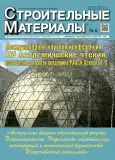Теоретические принципы, используемые для изучения процессов формирования полиэпоксиуретанизоциануратов. Часть 2
- Авторы: Кеймах М.Д.1, Езерницкая М.Г.1, Каранди И.В.1, Аскадский А.А.1,2
-
Учреждения:
- Институт элементоорганических соединений им. А.Н. Несмеянова РАН
- Национальный исследовательский Московский государственный строительный университет
- Выпуск: № 6 (2024)
- Страницы: 52-59
- Раздел: Полимеры в строительстве
- URL: https://journals.eco-vector.com/0585-430X/article/view/635099
- DOI: https://doi.org/10.31659/0585-430X-2024-825-6-52-59
- ID: 635099
Цитировать
Полный текст
Аннотация
Проведено количественное описание влияния образующихся химических структур полиэпоксиуретанизоциануратов на величину температуры стеклования Tg и показатель преломления. Это осуществляется путем подбора сополимерных структур, величина Tg которых сопоставима с расчетной, при этом ошибка не превышает 1,8–2%. Теоретические данные получены на основании расчетов модельных структур с использованием компьютерной программы «Каскад» (ИНЭОС РАН).
Полный текст
Об авторах
М. Д. Кеймах
Институт элементоорганических соединений им. А.Н. Несмеянова РАН
Автор, ответственный за переписку.
Email: kejmakh.margo@yandex.ru
канд. хим. наук
Россия, МоскваМ. Г. Езерницкая
Институт элементоорганических соединений им. А.Н. Несмеянова РАН
Email: ezernits@mail.ru
канд. хим. наук
Россия, МоскваИ. В. Каранди
Институт элементоорганических соединений им. А.Н. Несмеянова РАН
Email: margaret@ineos.ac.ru
канд. хим. наук
Россия, МоскваА. А. Аскадский
Институт элементоорганических соединений им. А.Н. Несмеянова РАН; Национальный исследовательский Московский государственный строительный университет
Email: andrey@ineos.ac.ru
д-р хим. наук
Россия, Москва; МоскваСписок литературы
- Кеймах М.Д., Езерницкая М.Г., Каранди И.В., Аскадский А.А. Экспериментальные данные по изучению процессов формирования полиэпоксиуретанизоциануратов. Ч. 1 // Строительные материалы. 2024. № 5. С. 4–11. DOI: https://doi.org/10.31659/0585-430X-2024-824-5-4-11
- Askadskii A.A. Physical properties of polymers. Prediction and control. Amsterdam: Gordon and Breach Publishers. 1996. 336 p.
- Аскадский А.А., Кондращенко В.И. Компьютерное материаловедение полимеров. М.: Научный мир, 1999. 543 с.
- Askadskii A.A. Computational materials science of polymers. Cambridge: Cambridge International Silence Publishing. 2003. 695 p.
- Аскадский А.А., Голенева Л.М., Афанасьев Е.С., Петунова М.Д. Градиентные полимерные материалы // Обзорный журнал по химии. 2012. № 2 (2). С. 115–164.
- Askadskii А.А., Goleneva L.M., Konstantinov K.V., Bychko К.А. Synthesis and investigation of properties of the gradient-modulus material based on polypropylene glycols and 2,4-toluylendiisocyanate // Russian Polymer News. 2001. No. 6 (2), pp. 6–11.
- Аскадский А.А., Константинов К.В., Голене- ва Л.М., Бычко К.А. Синтез и исследование свойств градиентных материалов на основе полипропиленгликолей и 2,4-толуилендиизоцианата // Высокомолекулярные соединения. Сер. А. 2002. № 44 (4). С. 567–576.
- Аскадский А.А., Голенева Л.М., Афанасьев Е.С., Петунова М.Д. Градиентные полимерные материалы // Обзорный журнал по химии. 2012. № 2 (4). С. 263–318.
- Askadskii A.A. Development and properties of gradient polymeric materials // Russian Polymer News. 1999. No. 4 (2), pp. 34–37.
- Аскадский А.А. Градиентные полимерные материалы. М.: Изд-во АСВ, 2024. 238 с.
- Петунова М.Д., Аскадский А.А., Лучкина Л.В., Голенева Л.М., Казанцева В.В., Коврига О.В. Одностадийный синтез и механические свойства сетчатых полиуретанизоциануратных полимерных материалов // Пластические массы. 2010. № 1. С. 30–39.
- Голенева Л.М., Аскадский А.А., Петунова М.Д., Коврига О.В. Градиентные полиуретанизоциануратные материалы на основе полипропиленгликоля, получаемые в одну стадию // Пластические массы. 2008. № 6. С. 17–22.
- Патент РФ 2252947. МПК C08J 5/04. Композиция для получения полимерных конструкционных материалов на основе полиизоциануратов / Аскадский А.А., Голенева Л.М., Киселева Т.И. Заявл. 25.06.2003. Опубл. 27.05.2005.
- Аскадский А.А., Лучкина Л.В., Бычко К.А., Голенева Л.М., Константинов К.В. Синтез, структура и свойства градиентных полимерных материалов, полученных на основе олигомерного полипропиленгликоля и 2,4-толуилендиизоцианата // Высокомолекулярные соединения. Сер. А. 2004. № 46 (4). С. 569–582.
- Лучкина Л.В., Петунова М.Д., Аскадский А.А., Казанцева В.В., Афоничева О.В. Cинтез и механические свойства градиентных композиционных полиуретанизоциануратных полимерных материалов на основе олигоокситетраметиленгликоля // Пластические массы. 2008. № 2. С. 22–24.
Дополнительные файлы


















